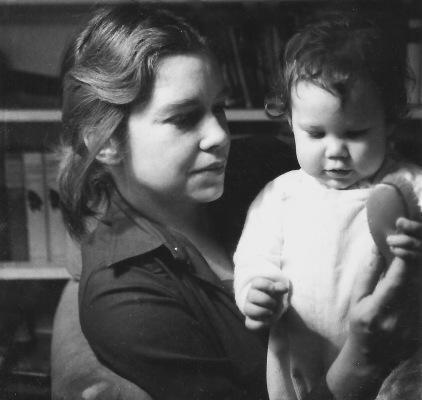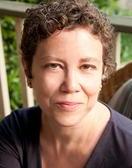
Mom, Me, 1961
My mother, Martha Legg Katz, died last month. I have been uncharacteristically quiet here, in public, since she fell ill in the heat of August. When she died in September at home–my childhood home–I stood in the driveway watching the full moon rise behind a scrim of tall New England pines. Now it is October and the full moon has come and gone again. And so it feels like it is time to return to all of you.
In Judaism, there are special rules for shiva, the first seven days after the burial, and for shloshim, the first thirty days. These rules help to insulate the mourner from the banality and hectic nature of the casual world, and help us figure out how to eventually emerge from the fog of grief and go on with life. Some of these rules–let your hair grow wild, wear old clothes–make sense to me in a primal way, and seem comforting. Others–no music, no luxurious baths–seem harsh and frankly counter-intuitive.
I do not feel bound by any of these rules, although I find them fascinating and in some cases helpful. Of course, my mother was not Jewish. She married a Jewish man, stopped going to church, raised Jewish children. Often alone on this journey in the 1960s and 70s, inventing as she went along, she created a role for herself as a pioneering interfaith spouse and parent.
My book, Being Both, opens with my mother baptizing me in the kitchen sink. The story of her successful interfaith marriage inspired my work, threads through my book, and comes up in every talk or workshop I give on interfaith families. The epic love between my parents has resonated with people around the country and the world who never met my mother in person. And so, although I have no great desire to mourn in public, I feel I have to acknowledge this immense transition in my life with public words, before I can really go on with writing about anything else.
Medieval scholar Maimonides traces shloshim, the first thirty days of mourning, to Deuteronomy 21:13. In this passage, soldiers are commanded to allow a captive woman to “bewail her father and her mother a full month” before taking her as a wife. Here, the pain of mourning is compounded by the context of war—a context found in many ancient religious texts, all written by men. As a bereaved daughter, I do find poignant the brief pause in mayhem to acknowledge the depth of grief a daughter would have for lost parents. It is also interesting to note that this passage points to the ongoing intimate relations–in war and peace–between the tribes of Israel and neighboring tribes.
But, returning to 21st century America, I have been figuring out how to bewail the loss of my mother in the context of a contemporary interfaith family. As with any life cycle event in our family, that means thinking deeply about which Jewish practices and which Christian practices hold meaning for us. We get to decide how to intertwine them, while respecting the history of each, and also celebrating the reality of our successful interfaith family.
For us, this has meant balancing a desire to meet the needs of my Jewish father, the principal mourner, with the desire to honor my Protestant mother. As always with interfaith families, the way we layer or weave together two sets of rituals will look different for each family. For my father, burying my mother in his family’s Jewish cemetery was essential, so that is what we did. We embraced the Jewish idea of a closed wooden casket without metal fittings as resonant with environmental principles important to me and to my siblings. And we chose the Jewish ritual of watching the casket lowered into the grave, in order to experience the reality of burial, rather than leaving the cemetery while the casket is still above ground, as is common at Christian burials. Our brief graveside service culminated with saying Kaddish, because most of the graveside mourners were from my large and very close Jewish family–the family that embraced my mother 56 years ago when she married my father.
At the same time, it would have been clear to any observer that day that we are an interfaith family, not simply a Jewish family. Although traditionally there is no music at a Jewish burial, we began our service with an a cappella Protestant hymn—albeit one that was included in Reform Judaism’s Union Prayer Book. The family members at the graveside included an Episcopal priest, and three Catholic grandchildren who are altar servers. And various in-laws arranged for Catholic masses to be said in memory of my mother, at The National Shrine of Our Lady of the Snows in Illinois, and at Saint Peter’s in Rome. All this, both the Jewish and Christian ways of remembering her, would have pleased my mother greatly. A comparative religion major, she loved the ritual, and the mystery, of all our family traditions.
I find it encouraging that some interfaith family funerals now include Jewish and Christian clergy co-officiating. But we chose to have neither a rabbi nor a minister. Jewish tradition does not require clergy for a burial (or for a wedding, or a bar mitzvah, for that matter). Having a rabbi preside when my mother was not Jewish did not seem right. On the other hand, having a minister preside in a Jewish cemetery when my Jewish father was the principal mourner did not seem right either. And having both, and negotiating their roles, seemed like too much for our brief graveside ritual. So I led the service myself. I think this, too, would have pleased my mother. As an interfaith family, I believe we are called on to build bridges of peace in life, and even in death.
Susan Katz Miller is the author of Being Both: Embracing Two Religions in One Interfaith Family, from Beacon Press. She works as an interfaith families consultant, speaker, and coach. Follow her on twitter @beingboth.

